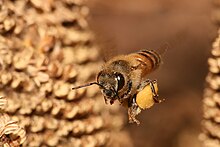Honey bee
| Honey bees | |
|---|---|

| |
| Western honey bee carrying pollen back to the hive | |
| Scientific classification | |
| Domain: | Eukaryota |
| Kingdom: | Animalia |
| Phylum: | Arthropoda |
| Class: | Insecta |
| Order: | Hymenoptera |
| Family: | Apidae |
| Subfamily: | Apinae |
| Tribe: | Apini Latreille, 1802 |
| Genus: | Apis Linnaeus, 1758 |
| Species | |
| |
A honey bee (or honeybee) is any bee that is a member of the genus Apis. They are all eusocial flying insects which live in colonies of various sizes.
They are only a small fraction of the 20,000 known species of bee. They produce and store honey and make perennial, colonial nests from wax. There are both stinging and stingless honey bees.
Honey bees are the only living members of the tribe Apini, all in the genus Apis. There are only seven species of honey bee, with a total of 44 subspecies.[1] Historically, from six to eleven species have been recognized.
Some other types of bees produce and store honey, but only members of the genus Apis are true honey bees. The study of honey bees is known as ''melittology''.
The first Apis bees appear in the European fossil record at the Eocene–Oligocene boundary (34 million years ago). This shows that the bees were present in Europe by that time. Few fossil deposits are known from South Asia, the suspected region of honey bee origin.
No Apis species existed in the New World during human times before the introduction of A. mellifera by Europeans. Only one fossil species is known, a single 14-million-year-old specimen from Nevada.[2]
The close relatives of modern honey bees – bumblebees and stingless bees – are also social, but with smaller numbers in their families.
All honey bees (and perhaps all bees) use scent as a way to co-ordinate their activities. Nasonov's gland produces a pheromone used to get worker bees together.[3] The pheromone can attract workers to a settled swarm and draw bees who have lost their way back to the hive.
Mating information[change | change source]
- Queens are produced by mating between females and drones (male), and are fed with royal jelly (honey and pollen). This special feeding is done during the second and third days of the larva's life. One queen per hive is usual. Nurse bees do the care and feeding of the queen and the next generation. They are haploid females.
- Mating takes place between a queen and drones from other colonies.
- A fertilized queen can lay male or female eggs. Eggs laid by the queen are usually unfertilized. They become haploid female workers: the bees seen usually collecting pollen and nectar from flowers are the female workers.
- The average lifespan of a queen is three to four years. Drones usually die after mating or are expelled from the hive before the winter. Workers live for a few weeks to several months.
Related pages[change | change source]
References[change | change source]
- ↑ Engel, Michael S. 1999. "The taxonomy of recent and fossil honey bees (Hymenoptera: Apidae: Apis)". Journal of Hymenoptera Research. 8: 165–196.
{{cite journal}}: CS1 maint: numeric names: authors list (link) - ↑ Michael S. Engel; et al. (2009). "A honey bee from the Miocene of Nevada and the biogeography of Apis (Hymenoptera: Apidae: Apini)". Proceedings of the California Academy of Sciences. 60 (3): 23–38.
- ↑ Zoubaref A.; Benton, Frank, trans. 1883. Concerning an organ of the bee not yet described. The British Bee Journal 11: 296–297.
